The Highland Dutch

By Jim Naughton
THERE’S THE HIGHLAND DUTCH, AND THE LOWLAND DUTCH…The Dutch in NATO FORCES
For no specific reason, I was reminded of an old Pennsylvania drinking song when I first read the Dutch section of the NATO FORCES book. I was disappointed (but not surprised) when I saw the new book, which takes fantasy to a new level, postulating things that didn’t happen until the ‘90s (five to fifteen years after the Team Yankee notional date of 1985). And most couldn’t happen in 1985 even if Andropov sent Reagan a memo in January 1985, saying “War in August, you-all come.”
For example, Dutch Leopard 2A5. The Dutch get this beast at a slight discount compared to the West Germans. You could hypothesize that the clever West Germans could slap some prototype applique on their limited production of Leopard 2A4s and produce perhaps a company of ‘advanced’ tanks in 1985. But give them to the Dutch? Leopard 2 production was no more than five tanks a week for the life of the production run.
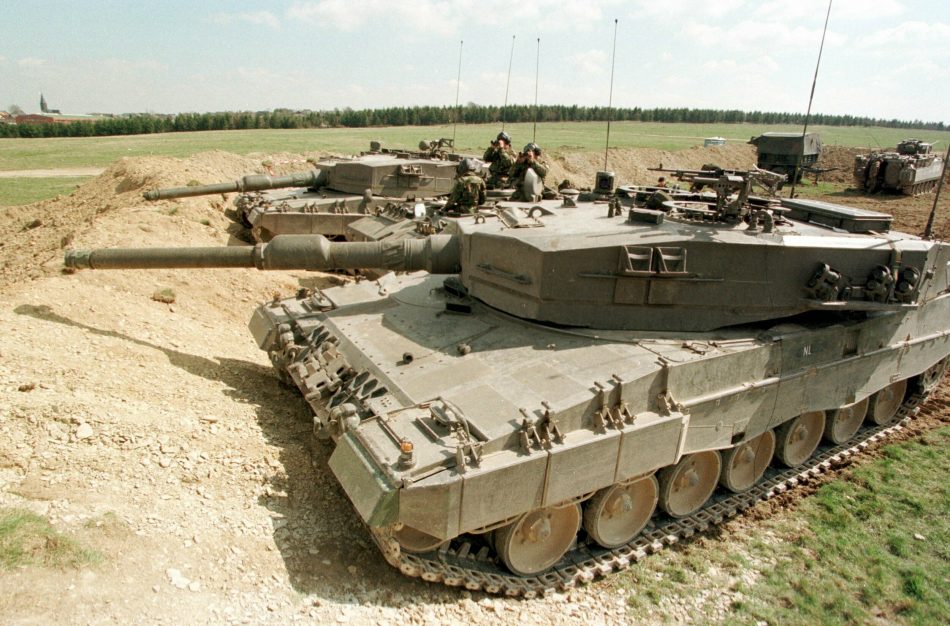
And in the Team Yankee scenario, Kiel GMBH, the co-producer of the Leopard 2, was in (you guessed it) Kiel and cut off from the rest of Germany if not actually occupied within three days. So perhaps three new tanks a week until Krauss-Maffei picked up the slack…maybe in September, and serious production (800 tanks a year, like the USA was producing) would take six months if the Soviets didn’t bomb the factory. Producing a company for the battered Panzer Lehr Brigade was just within reach…additional for the Dutch was well beyond possible.
Or the TOW-2. The TOW-2 required a different launcher than ITOW, ER TOW, and Basic TOW. The M2 and M3 Bradley had to be upgraded to M2A1 and M3A1 variants, as were the M901 Improved TOW Vehicle to M901A1. Converting the launchers wasn’t the work of a moment, and US production of the kits was identified for US vehicles (only!) in 1985. The first TOW-2 production was roughly 12,000 missiles a year in 1986, and a US Corps requirement was 9,000. So the US Army would not have any to spare until 1989, coincidentally when the TOW-2A was being delivered. Increased wartime production of TOW missiles would happen about six months after the shooting started according to Cold War industrial mobilization planning.

MLRS is another irritant. Co-production of MLRS in Europe began in 1989, with the Dutch confidently expecting to field their first in 1991. The MLRS batteries found in the UK, WG, and now NATO books were merely a gleam in the Minister of Defense’s eye in 1985.
Don’t get me started on Apaches. The Dutch procrastinated a decision on upgrading their aging Alouette III and BO-105s into the mid-90s; in 1987 they were still studying the problem. In 1996 they leased(!) 12 AH-64As and first took delivery of AH-64Ds in late 1998. HELLFIRE Missiles were unobtainable at any price outside US forces until 1990 anyway.
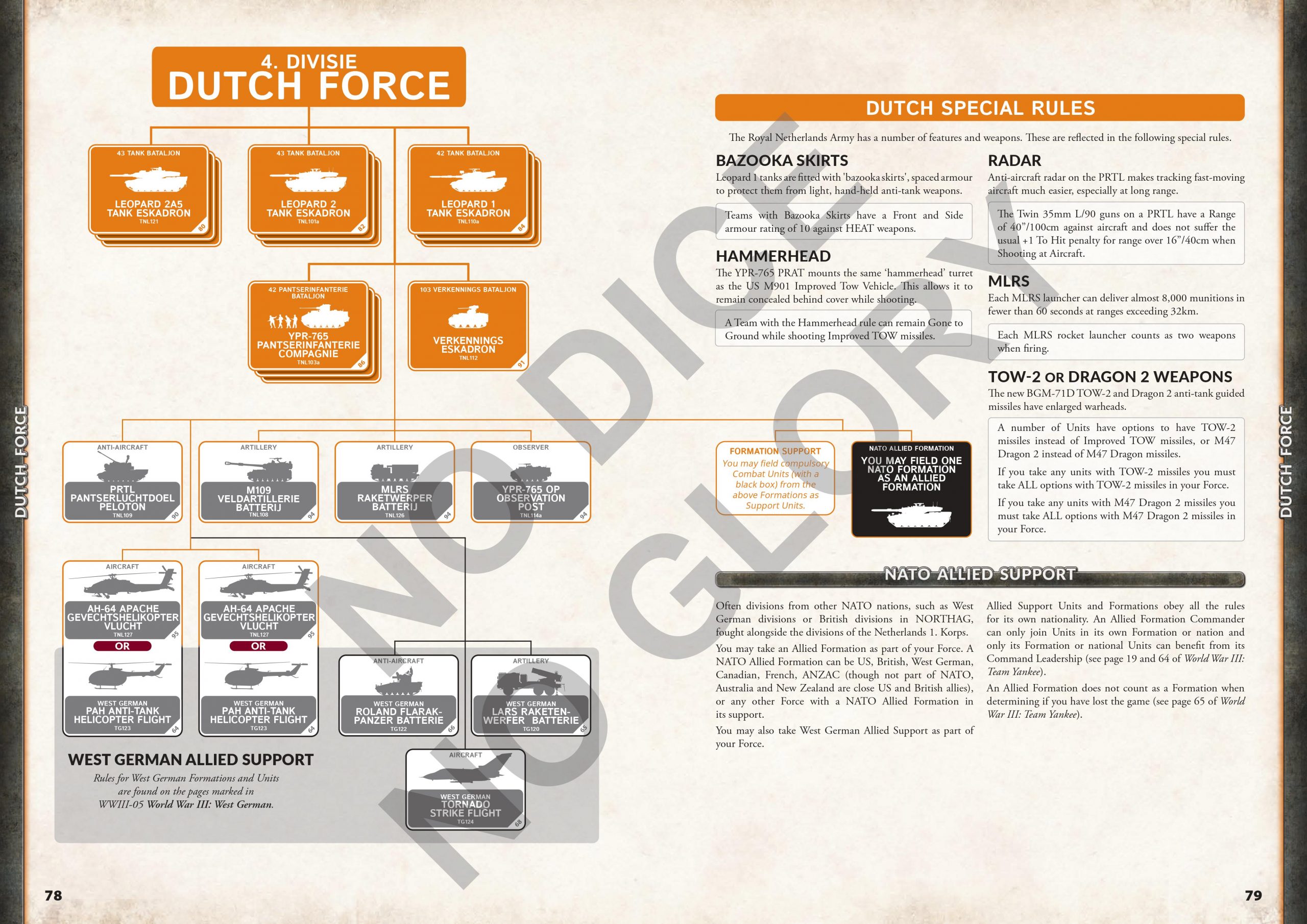
The last disconnect is DRAGON II. The USMC didn’t start getting theirs until 1988 and Talley finished producing for USMC in 1990, then went looking for new customers. Not happening before 1990.
Put a different way, the new Dutch force wasn’t possible in the real world of 1990, much less 1985. [Readers are encouraged to glance at NATO’s CENTRAL REGION FORCES, Anthony Cordesman, 1987, published by Jane’s Russian Military Power Series or any one of several Osprey Books on NATO military equipment for confirmation.]
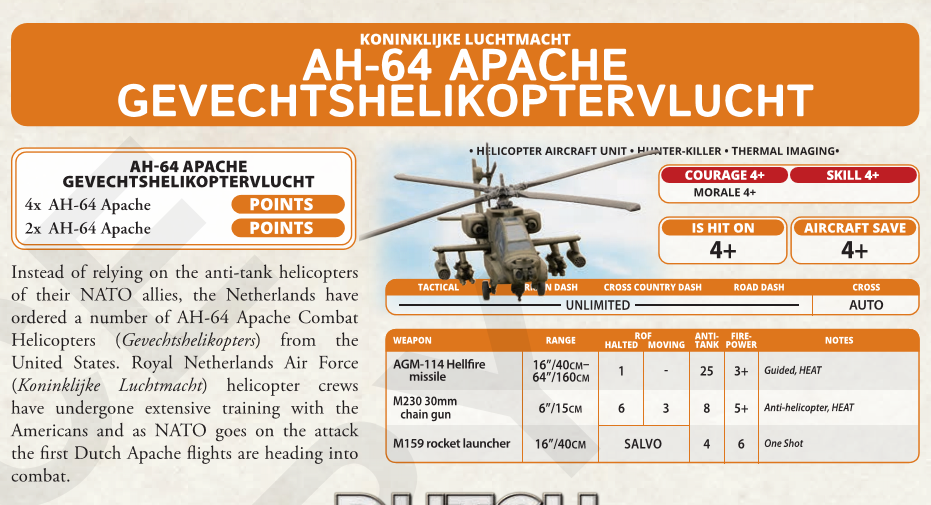
End of sermon. After all, it’s a game, and the 1985 barrier was breached a long time ago. Now let’s discuss what changed and what remained the same. The Dutch now can field an entire ESKADRON of Leopard 2A5. Ringing in at 16 AP, the full ESKADRON would cost 272 AP plus any PRTL, mortars, or recon found desirable. The Dutch version has all the features of the West German tank, and the steep price tag means it is unlikely to see more than a reduced strength platoon in any force less than 120 AP. They still have the option for Leopard 2A4 at 10 AP, making this a somewhat more likely candidate for lower point values.
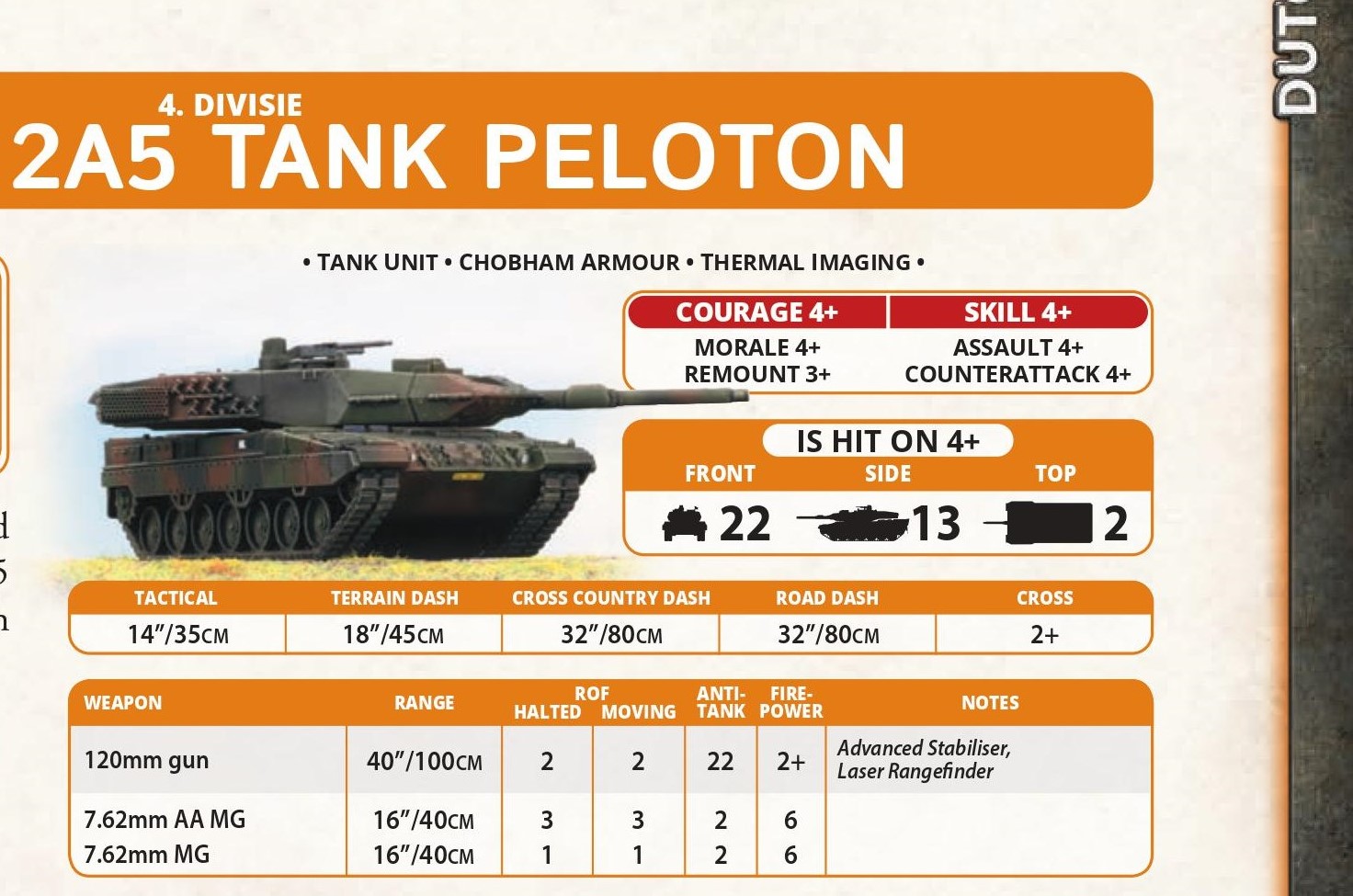
Their bread-and-butter tank is still the Leopard I, and a full ESKADRON costs 51 AP, just over the cost of a single platoon (3 tanks) of 2A5 or a minimum-size company (5 tanks) of 2A4. The Dutch Leopard I is still Infrared and bazooka skirts. Its gun is ‘Smoke, Stabilizers’ and AT=19. In other words, some of the upgrades that appeared in NORDIC Forces Leopard Is didn’t translate to the Dutch.
Although AT=19 seems quite anemic, it is quite useful in shredding light armor including the dreaded Marder II. From personal (unpleasant) experience I can attest to its efficiency in killing infantry despite not being brutal. And you can buy them in enough numbers to reliably outflank big kahuna tanks (imagine three Abrams M1A1 HC trying to deal with 18 Leopard Is and you see what I mean). Don’t leave home without them.
All the Tank Eskadrons have PRAT antitank sections, mortars, and recon.
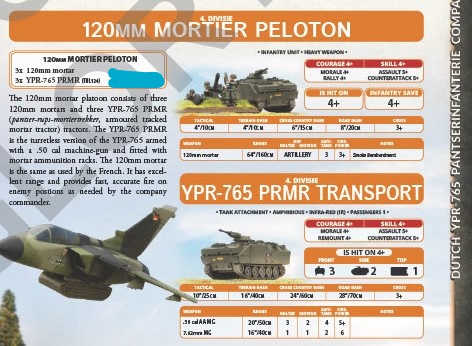
The Dutch YPR-765 PANTSERINFANTERIE COMPAGNIE is somewhat changed from the original FREE NATIONS. The Infantry PELOTON can upgrade its DRAGONs for 1 AP to AT=21 DRAGON II missiles with the same range as basic DRAGON. The COMPAGNIE also includes the option for dismountable 120mm mortars, a trend first shown in RED DAWN and continued in NORDIC FORCES. The three mortars come with a transport attachment of YPR-765 PRMR (machinegun only) vehicles.
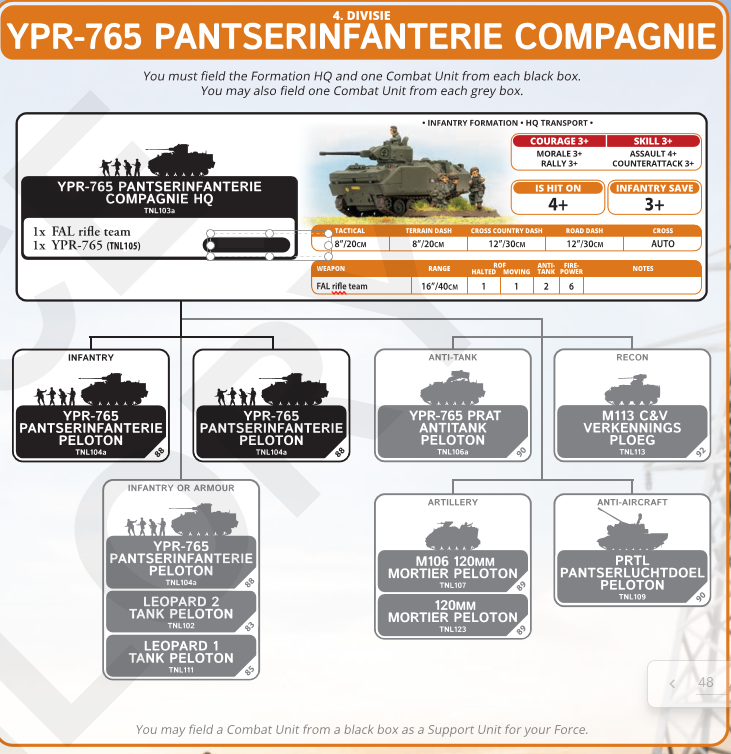
And, of course, the YPR-765 PANTSER-RUPT-ANTITANK (PRAT) can be upgraded to TOW-2 at one point per section. The upgraded TOW-2 and DRAGON II have the same requirement as the US TOW-2: All Dutch units having the basic item must be upgraded or none. The COMPAGNIE’s PELOTONs still have Carl Gustavs in profusion, making them a candidate for ‘toughest to overrun with tanks,’ rivaling the Irish Guards.
The COMPAGNIE can substitute a Leopard I PELOTON or Leopard 2A4 PELOTON for one of the three INFANTERIE PELOTONs in the formation. Likewise, the tank ESKADRONs can substitute an INFATERIE PELOTON for one of their four tank PELOTONs.
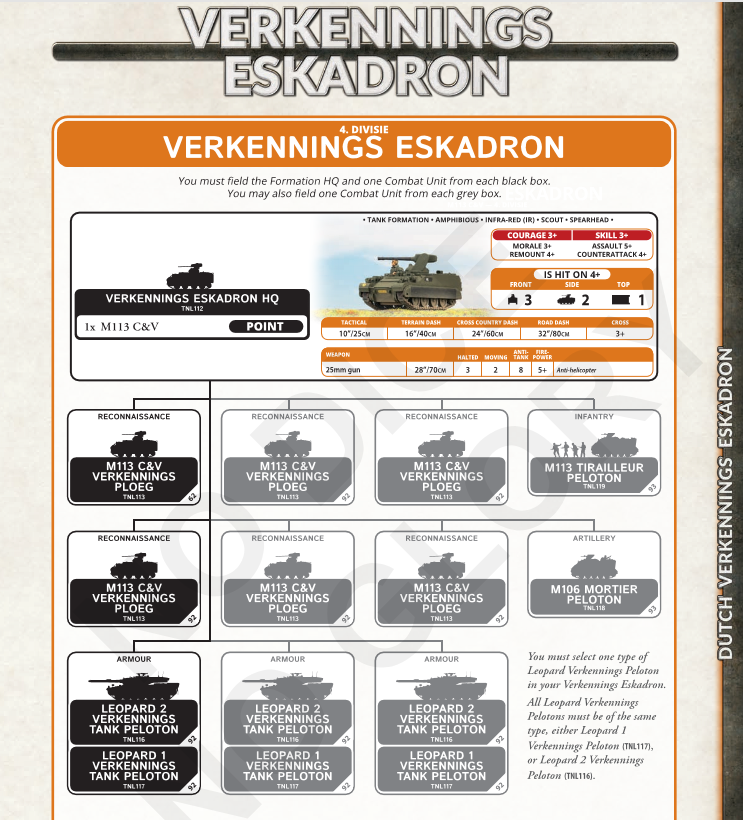 The VERKENNINGS (Reconnaissance) ESKADRON remains unchanged from FREE NATIONS. It consists of up to six pairs (PLOEG or sections) of M113 C&V with 25mm cannon, three ‘PELOTONs’ of Leopard 2A4 or Leopard I tanks, still in pairs, a Tirailleur PELOTON in M113s (no DRAGONs) and an M106 mortar PELOTON. The major weakness of this formation is Dutch morale; one stubbornly bailed vehicle can easily take out the whole section.
The VERKENNINGS (Reconnaissance) ESKADRON remains unchanged from FREE NATIONS. It consists of up to six pairs (PLOEG or sections) of M113 C&V with 25mm cannon, three ‘PELOTONs’ of Leopard 2A4 or Leopard I tanks, still in pairs, a Tirailleur PELOTON in M113s (no DRAGONs) and an M106 mortar PELOTON. The major weakness of this formation is Dutch morale; one stubbornly bailed vehicle can easily take out the whole section.
Sadly, the Dutch Force lacks some units that existed in 1985, like the five Army and six Territorial motorized infantry battalions, a commando/parachute battalion, and two Centurion reserve tank battalions. I’m guessing space in the book put the units out of reach.
Dutch support originally included a unit of M109 howitzers, a battery of PRTL Pantserluchtdoel, and an Observer. They could also draw on West Germans for direct support including ROLAND, PAH attack helicopters, LARS and TORNADO strike aircraft. These options remain in place.
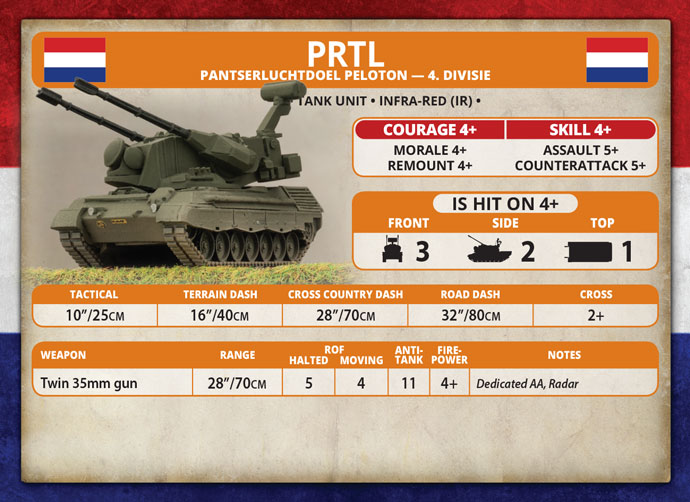
PRTL Batteries are also still found in the Tank Eskadrons and YPR Companies. The standard unit is 3 weapons and can be supplemented by as many STINGER teams as you have guns. The PRTL is more popular as an assault gun but remains deadly against aircraft.
The new support options include AH-64 and MLRS. AH-64 costs the same (a pair for 12 AP; almost twice the cost of PAH) and performs the same as the American system. Not surprising considering the Dutch have the same soft statistics as Americans. The Dutch MLRS come with minelets for +1 AP. Like other MLRS, they count two weapons firing per model.
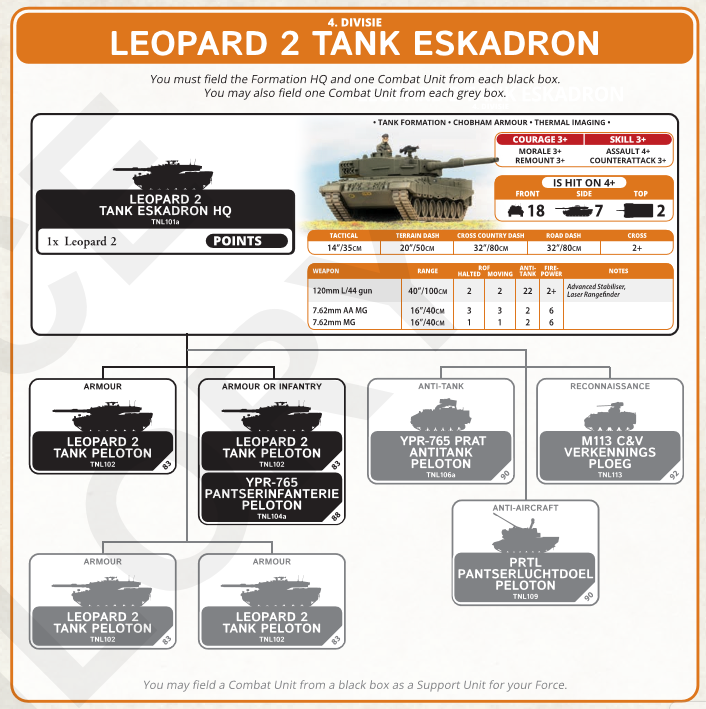
That covers the new Dutch Force. My overall impression is (setting aside the high fantasy content) that it does the Dutch few favors. Perhaps in a 150-point game with the players prevented from taking any tank with FA<15 (which would preclude using Leopard Is) and limiting infantry to one unit, having 2A5 would be helpful. Dragon II is nice, and cheap enough that I imagine it will become a no-brainer choice. MLRS or LARs is a wash unless you buy the third MLRS…spending more points.
The choice between two APACHEs or four PAHs leans toward the PAH. The APACHE brings 4+ save and long range but killing four teams is harder than two teams. Paying extra for the TOW-2 PRAT isn’t a bad idea if you just take one PRAT unit, but if you opt for big tanks every point counts. And unlike the USA the premium to get large numbers of PRAT is high – each unit requires a formation.

In summary, the new Dutch equipment gives modelers an opportunity to paint 2A5, Apache, and MLRS and put Dutch decals on them. But I doubt the competitive Dutch lists that have evolved in the past five years will change other than by incorporating Dragon II and TOW-2 in their infantry units.
We had a saying in the US Army acquisition community: “The enemy of GOOD ENOUGH is BETTER.” The FREE NATIONS Dutch Force was tough i.e. GOOD ENOUGH. The new Force is arguably BETTER, in that it has some new options (even if fantasy). But the AP invested in the new options will not necessarily produce winning lists, because the bread-and-butter troops must necessarily give way to the pricier units.

Thanks for the insights. I play Dutch for NORTHAG as I’m not much of a Team Yankee fan, but it was good read your insights. Being a big fan of the KL I was very disappointed by the weirdness that has arisen in the way the 1983-85 army is presented. (There are some questionable items in the NORTHAG/CENTAG army lists as well) By the way, if you really want fantasy, look at the suggested paintjobs FoW has suggested for the East Germans. A camo pattern that didn’t bubble up until 1989, didn’t start to get applied (to only a few vehicles in two divisions) until after the wall opened and yet seems to be on many 1985-era armies these days. Yeah, it’s fantasy gaming alright.
the problem (as I see it) is that introducing ERA tanks has thrown NATO players into confusion. The Soviets had ERA tiles in storage in the Western Soviet Union from 1983 and in EG from 1985, so in effect they were always there in the game window. 1987 saw the ‘big reveal’ (an American Undersecretary of Defense called it ‘the weekend when the Soviets made all our missiles obsolete).
Suddenly having Soviet/PACT tanks in the game that could shrug off the NATO wunder-weapon Carl Gustav created a demand for a counter and so suddenly the Dutch have 2A5, TOW-2, Dragon-2 and the UK, WG, French etc have MILAN-2 (which is really MILAN-2T or even MILAN-3). The customer is always right…so we have impervium tanks and unobtainium missiles. Real world, these counters either never existed (MILAN-2’s game characteristics) or were useless against KONTAKT-1/5 (DRAGON-2)or too pricey for the small NATO nations to upgrade launchers (TOW-2). It was years before NATO even countered KONTAKT-1.
Why won’t BF allow a full recon plt as 1 unit ie 5 x M113 C&V , 2 Leo 1 or 2 , 1 M113 with an inf section and 1 M106 ?
Or even allow POSO, being the Dutch acronym for Platoon Organisation Suspended (Pelotons-Organieke Samenstelling Opgeheven) for a Sqn where there would be , 2 x 7 M113 C&V , 1 x 6 Leo 1 or 2 , 1 M113 C&V + 3 x M113 each with an inf section and 3 x M106 for a Sqn ?
So at a guess the stinger MANPADs haven’t been changed to 1 per PTRL ?
https://www.orbat85.nl/reference/unit-organisation-and-equipment.html#paluabt
Sorry, nothing changed here so I didn’t dwell on it. The wording for PTRL/Stinger remains exactly the same as FREE NATIONS. You take a PTRL unit, and then take the STINGER infantry attachment. The STINGER infantry attachment is 2 or 3 teams, so in effect the MAX is 1 per PTRL. However, you can buy a two STINGER team attachment for a 3 PTRL unit.
Yep but in the list you get a max of 9 Stinger teams per 3 PTRL , not the 1 per PTRL they actually had . So in the list a PTRL plt can have as many Stingers as a full Coy had !!!!
Assume you’re counting launchers and referring to the number of launchers found on a base, i.e. teams with a small ‘t’ vice Teams with a large ‘T’. This has been a game artifice since the Soviet Gremlin teams back in the mists of time. Every BMP/BTR (ideally) carried a Gremlin/Grail/Gimlet which was operated by an infantryman and so BF gave us a ‘representation’ of the dedicated SA-14 teams found in regimental ADA platoons plus the infantrymen in the 3-launcher base that potentially joins every platoon if you (like me) field small units with 6xBMPs or 8xBTR as standard. They did the same with the WG. Don’t understand why they gave USA HMMWV Stingers and LAV-ADA with attitude. All nations should have two-man bases with one MANPADs. And varying allocations of MANPADs. USA had a max of 60 Stinger teams in a DIVISION (except 9th ID), one two-man team however represented per FORMATION. Same problem with the PTRL/Gepard/Vulcan/York. Sigh.
Both the Dutch and Belgians had an AA Battalion with 27 PTRL/Gepard per Division , so it comes out at 1 plt of 3 per tank/inf battalion .
27 per division = 3 per BATTALION = 1 per COMPANY = 1 per BF Formation. The Dutch had 474 basic Stinger missiles which is a little less than six MISSILES per PTRL. Only 10,000 Stingers had been produced total, less a couple hundred sent to Afghanistan in 1986. These were all basic Stingers. Stinger POST production began in USA in 1986 and began fielding in 1987. These were all US missiles. Stinger RMP began production in 1989. A consortium including Netherlands had signed up for European co-production and the co-production didn’t begin until 1989. So through the ’80s the Dutch were stuck with 474 early Stingers making a 3-launcher stand a serious candidate for ‘ONE SHOT’.